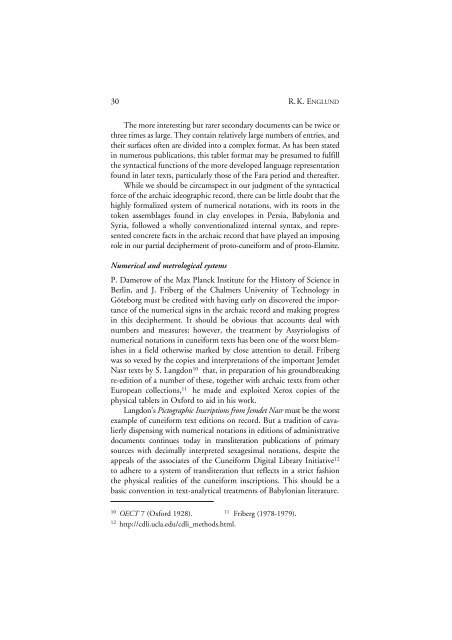PDF copy - Cuneiform Digital Library Initiative - UCLA
PDF copy - Cuneiform Digital Library Initiative - UCLA
PDF copy - Cuneiform Digital Library Initiative - UCLA
You also want an ePaper? Increase the reach of your titles
YUMPU automatically turns print PDFs into web optimized ePapers that Google loves.
30 R.K. ENGLUND<br />
The more interesting but rarer secondary documents can be twice or<br />
three times as large. They contain relatively large numbers of entries, and<br />
their surfaces often are divided into a complex format. As has been stated<br />
in numerous publications, this tablet format may be presumed to fulfill<br />
the syntactical functions of the more developed language representation<br />
found in later texts, particularly those of the Fara period and thereafter.<br />
While we should be circumspect in our judgment of the syntactical<br />
force of the archaic ideographic record, there can be little doubt that the<br />
highly formalized system of numerical notations, with its roots in the<br />
token assemblages found in clay envelopes in Persia, Babylonia and<br />
Syria, followed a wholly conventionalized internal syntax, and represented<br />
concrete facts in the archaic record that have played an imposing<br />
role in our partial decipherment of proto-cuneiform and of proto-Elamite.<br />
Numerical and metrological systems<br />
P. Damerow of the Max Planck Institute for the History of Science in<br />
Berlin, and J. Friberg of the Chalmers University of Technology in<br />
Göteborg must be credited with having early on discovered the importance<br />
of the numerical signs in the archaic record and making progress<br />
in this decipherment. It should be obvious that accounts deal with<br />
numbers and measures; however, the treatment by Assyriologists of<br />
numerical notations in cuneiform texts has been one of the worst blemishes<br />
in a field otherwise marked by close attention to detail. Friberg<br />
was so vexed by the copies and interpretations of the important Jemdet<br />
Nasr texts by S. Langdon10 that, in preparation of his groundbreaking<br />
re-edition of a number of these, together with archaic texts from other<br />
European collections, 11 he made and exploited Xerox copies of the<br />
physical tablets in Oxford to aid in his work.<br />
Langdon’s Pictographic Inscriptions from Jemdet Nasr must be the worst<br />
example of cuneiform text editions on record. But a tradition of cavalierly<br />
dispensing with numerical notations in editions of administrative<br />
documents continues today in transliteration publications of primary<br />
sources with decimally interpreted sexagesimal notations, despite the<br />
appeals of the associates of the <strong>Cuneiform</strong> <strong>Digital</strong> <strong>Library</strong> <strong>Initiative</strong>12 to adhere to a system of transliteration that reflects in a strict fashion<br />
the physical realities of the cuneiform inscriptions. This should be a<br />
basic convention in text-analytical treatments of Babylonian literature.<br />
10 OECT 7 (Oxford 1928). 11 Friberg (1978-1979).<br />
12 http://cdli.ucla.edu/cdli_methods.html.
















